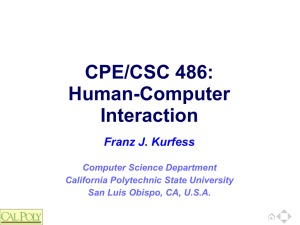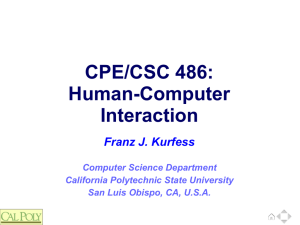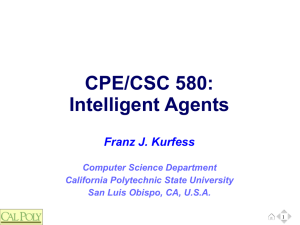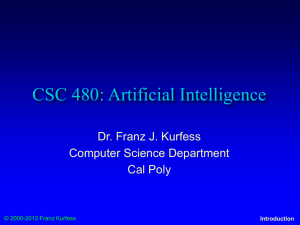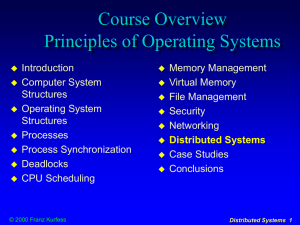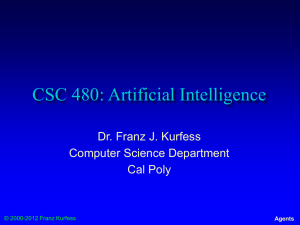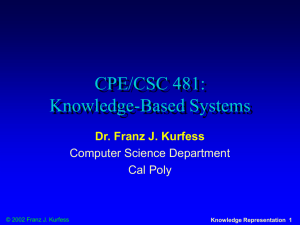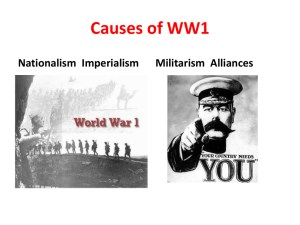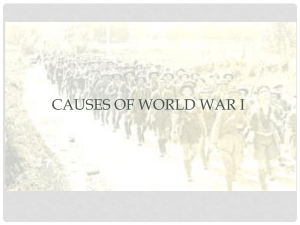5-Games
advertisement
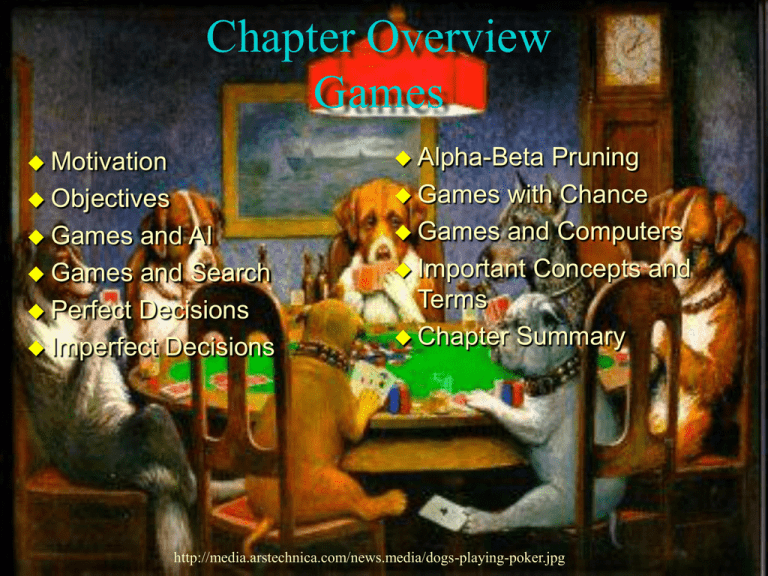
Chapter Overview
Games
Motivation
Objectives
Games
and AI
Games and Search
Perfect Decisions
Imperfect Decisions
Alpha-Beta
Pruning
Games with Chance
Games and Computers
Important Concepts and
Terms
Chapter Summary
http://media.arstechnica.com/news.media/dogs-playing-poker.jpg
© 2000-2012 Franz Kurfess
Games
Logistics - Oct. 18, 2012
❖
AI Nugget presentations scheduled
❖
❖
❖
William Budney: SwiftKey (delayed from Oct. 18)
Haikal Saliba: quantum algorithms in machine learning (delayed from Oct. 18)
Joseph Hain: Linux MCE - Home Automation
Jonathan Uder: Google's Autonomous Vehicle
Doug Gallatin: BWAPI and competitions, Overmind AI in detail
Dennis Waldron: ICODES
Section 3:
Andrew Guenther: Valve's Left 4 Dead AI Director (delayed from Oct. 18)
Kris Almario: Multi Robot Soccer AI
Ilya Seletsky: Action Game AI (FPS)
Assignments
A1 due tonight (Tue, Oct. 23, end of the day)
late submission penalty: 10% per business day
Labs
Lab 5 due tonight
Lab 6 available
Quizzes
❖
Section 1:
Quiz 5 available
Project
mid-quarter project fair on Thu, Oct. 25
revise project documentation
© Franz J. Kurfess
4
Motivation
examine
the role of AI methods in games
some game provide challenges that can be formulated as
abstract competitions with clearly defined states and rules
programs for some games can be derived from search methods
narrow view of games
games
can be used to demonstrate the power of computerbased techniques and methods
more challenging games require the incorporation of
specific knowledge and information
expansion of the use of games
from entertainment to training and education
© 2000-2012 Franz Kurfess
Games
Objectives
explore
the combination of AI and games
understand the use and application of search
methods to game programs
apply
refined search methods such as minimax to simple
game configurations
use alpha-beta pruning to improve the efficiency of game
programs
understand the influence of chance on the solvability of
chance-based games
evaluation
of methods
suitability
of game techniques for specific games
suitability of AI methods for games
© 2000-2012 Franz Kurfess
Games
Games and Computers
games
“I’m
some
offer concrete or abstract competitions
better than you!”
games are amenable to computer treatment
mostly
mental activities
well-formulated rules and operators
accessible state
others
are not
emphasis
on physical activities
rules and operators open to interpretation
need for referees, mitigation procedures
state
not (easily or fully) accessible
© 2000-2012 Franz Kurfess
Games
Games and AI
traditionally,
the emphasis has been on a narrow
view of games
formal
treatment, often as an expansion of search
algorithms
more
recently, AI techniques have become more
important in computer games
computer-controlled
characters (agents)
more sophisticated story lines
more complex environments
better overall user experience
© 2000-2012 Franz Kurfess
Games
Cognitive Game Design
story
development
generation of interesting and appealing story lines
variations in story lines
analysis of large-scale game play
character
development
modeling and simulation of computer-controlled agents
possibly enhancement of user-controlled agents
immersion
strong engagement of the player’s mind
emotion
integration of plausible and believable motion in characters
consideration of the user’s emotion
pedagogy
achievement of “higher” goals through entertainment
© 2000-2012 Franz Kurfess
Games
Game Analysis
often
deterministic
the outcome of actions is known
sometimes an element of chance is part of the game
e.g. dice
two-player,
one move for each player
zero-sum
utility function
what one player wins, the other must lose
often
turn-taking
perfect information
fully observable, everything is known to both players about the state of
the environment (game)
not for all games
e.g. card games with “private” or “hidden” cards
Scrabble
© 2000-2012 Franz Kurfess
Games
Games as Adversarial Search
many
games can be formulated as search problems
the zero-sum utility function leads to an adversarial
situation
in
order for one agent to win, the other necessarily has to
lose
factors
complicating the search task
potentially
huge search spaces
elements of chance
multi-person games, teams
time limits
imprecise rules
© 2000-2012 Franz Kurfess
Games
Difficulties with Games
games
yet
reasonably easy to formalize
finding the optimal solution may be impractical
can be very hard search problems
a solution that beats the opponent is “good enough”
unforgiving
a solution that is “not good enough” leads to higher costs, and to a loss to
the opponent
example:
size
chess
of the search space
branching factor around 35
about 50 moves per player
about 35100 or 10154 nodes
about 1040 distinct nodes (size of the search graph)
© 2000-2012 Franz Kurfess
Games
Games and Search
the
actions of an agent playing a game can often be
formulated as a search problem
some factors make the use of search methods
challenging
multiple
players
actions of opponents
chance events (e.g. dice)
consideration of probabilities
...
© 2000-2012 Franz Kurfess
Games
Search Problem Formulation
initial
state
board, positions of pieces
whose turn is it
successor
list of (move, state)
defines the legal moves, and the resulting states
terminal
test
also called goal test
determines when the game is over
calculate the result
utility
function (operators)
usually win, lose, draw; sometimes a score (see below)
or payoff function
numeric value for the outcome of a game
© 2000-2012 Franz Kurfess
Games
Single-Person Game
conventional
search problem
identify
a sequence of moves that leads to a winning state
examples: Solitaire, dragons and dungeons, Rubik’s cube
little attention in AI
some
games can be quite challenging
some
versions of solitaire
Rubik’s cube
a heuristic for this was found by the Absolver theorem prover
© 2000-2012 Franz Kurfess
Games
Contingency Problem
uncertainty
due to the moves and motivations of the
opponent
tries
to make the game as difficult as possible for the
player
attempts to maximize its own, and thus minimize the player’s utility
function value
different
from contingency due to neutral factors, such as
chance
outside influence
© 2000-2012 Franz Kurfess
Games
Two-Person Games
games
often called MIN and MAX
usually MAX moves first, then they take turns
in game terminology, a move comprises two steps (“plies”)
one by MAX and one by MIN
MAX
full
wants a strategy to find a winning state
no matter what MIN does
MIN
does the same
or at least tries to prevent MAX from winning
information
both players know the full state of the environment
partial
with two opposing players
information
one player only knows part of the environment
some aspects may be hidden from the opponent, or from both players
© 2000-2012 Franz Kurfess
Games
Perfect Decisions
based
on an rational (optimal) strategy for MAX
traverse
all relevant parts of the search tree
this must include possible moves by MIN
identify
often
a path that leads MAX to a winning state
impractical
time
and space limitations
© 2000-2012 Franz Kurfess
Games
MiniMax Strategy
optimal
not
strategy for MAX
very practical
•generate the whole game tree
•calculate the value of each terminal state
•based on the utility function
•calculate the utilities of the higher-level nodes
•starting from the leaf nodes up to the root
•MAX selects the value with the highest node
•MAX assumes that MIN in its move will select
the node that minimizes the value
© 2000-2012 Franz Kurfess
Games
MiniMax Value
utility
of being in the state that corresponds to a node
from MAX’s perspective: MAX tries to move to a state with the
maximum value, MIN to one with the minimum
assumes that both players play optimally
function MiniMax-Value(state) returns a utility value
if Terminal-Test(state) then
return Utility(state)
else if Max is to move then
return the highest MiniMax-Value of Successors(state)
else
return the lowest MiniMax-Value of Successors(state)
© 2000-2012 Franz Kurfess
Games
MiniMax Algorithm
selects
the best successor from a given state
invokes MINIMAX-VALUE for each successor state
function MiniMax-Decision(state) returns action
for each s
in
Successors[state] do
Value[s] := MiniMax-Value(s)
end
return action
© 2000-2012 Franz Kurfess
with the highest Value[s]
Games
MiniMax Properties
based
on depth-first
recursive
time
implementation
complexity is O(bm)
exponential
space
b
m
in the number of moves
complexity is O(b*m)
branching factor
maximum depth of the search tree
© 2000-2012 Franz Kurfess
Games
MiniMax Example
4
7
9
6
9
8
8
5
6
7
5
2
3
2
5
4
9
3
terminal nodes: values calculated from the utility function
© 2000-2012 Franz Kurfess
Games
MiniMax Example
4
7
6
2
6
3
4
5
1
2
5
4
1
2
6
3
4
3
Min
4
7
9
6
9
8
8
5
6
7
5
2
3
2
5
4
9
3
other nodes: values calculated via minimax algorithm
© 2000-2012 Franz Kurfess
Games
MiniMax Example
7
6
5
5
6
4
Max
4
7
6
2
6
3
4
5
1
2
5
4
1
2
6
3
4
3
Min
4
7
9
6
9
8
© 2000-2012 Franz Kurfess
8
5
6
7
5
2
3
2
5
4
9
3
Games
MiniMax Example
5
7
3
6
4
5
Min
5
6
4
Max
4
7
6
2
6
3
4
5
1
2
5
4
1
2
6
3
4
3
Min
4
7
9
6
9
8
© 2000-2012 Franz Kurfess
8
5
6
7
5
2
3
2
5
4
9
3
Games
MiniMax Example
5
Max
5
7
3
6
4
5
Min
5
6
4
Max
4
7
6
2
6
3
4
5
1
2
5
4
1
2
6
3
4
3
Min
4
7
9
6
9
8
© 2000-2012 Franz Kurfess
8
5
6
7
5
2
3
2
5
4
9
3
Games
MiniMax Example
5
Max
5
7
3
6
4
5
Min
5
6
4
Max
4
7
6
2
6
3
4
5
1
2
5
4
1
2
6
3
4
3
Min
4
7
9
6
9
8
8
5
6
7
5
2
3
2
5
4
9
3
moves by Max and countermoves by Min
© 2000-2012 Franz Kurfess
Games
MiniMax Observations
the
values of some of the leaf nodes are irrelevant
for decisions at the next level
this also holds for decisions at higher levels
as a consequence, under certain circumstances,
some parts of the tree can be disregarded
it
is possible to still make an optimal decision without
considering those parts
© 2000-2012 Franz Kurfess
Games
Pruning
discards
parts of the search tree
guaranteed
not to contain good moves
guarantee that the solution is not in that branch or sub-tree
if both players make optimal (rational) decisions, they will never
end up in that part of the search tree
sub-optimal moves by the opponent may lead into that part
results
may increase the amount of calculations for the player, but does not change the
outcome of the game
in substantial time and space savings
as
a consequence, longer sequences of moves can be
explored
the leftover part of the task may still be exponential,
however
© 2000-2012 Franz Kurfess
Games
Alpha-Beta Pruning
certain
won’t result in a better evaluation value than a move further up in the
tree
they would lead to a less desirable outcome
applies
moves are not considered
to moves by both players
indicates the best choice for Max so far
never decreases
indicates the best choice for Min so far
never increases
extension
of the minimax approach
results in the same sequence of moves as minimax, but with less
overhead
prunes uninteresting parts of the search tree
© 2000-2012 Franz Kurfess
Games
Alpha-Beta Example 1
[-∞, +∞]
5
Max
[-∞, +∞]
best choice for Max
best choice for Min
Min
?
?
we assume a depth-first, left-to-right search as basic strategy
the range of the possible values for each node are indicated
initially [-∞, +∞]
from Max’s or Min’s perspective
these local values reflect the values of the sub-trees in that node;
the global values and are the best overall choices so far for Max or Min
© 2000-2012 Franz Kurfess
Games
Alpha-Beta Example 2
[-∞, +∞]
5
Max
[-∞, 7]
Min
7
best choice for Max
best choice for Min
?
7
Min obtains the first value from a successor node
© 2000-2012 Franz Kurfess
Games
Alpha-Beta Example 3
[-∞, +∞]
5
Max
[-∞, 6]
7
Min
6
best choice for Max
best choice for Min
?
6
Min obtains the second value from a successor node
© 2000-2012 Franz Kurfess
Games
Alpha-Beta Example 4
[5, +∞]
5
7
6
Max
Min
5
best choice for Max
best choice for Min
5
5
5
Min obtains the third value from a successor node
this is the last value from this sub-tree, and the exact value is known
Max now has a value for its first successor node, but hopes that
something better might still come
© 2000-2012 Franz Kurfess
Games
Alpha-Beta Example 5
[5, +∞]
[-∞, 3]
5
7
6
5
best choice for Max
best choice for Min
5
Max
Min
3
5
3
Min continues with the next sub-tree, and gets a better value
Max has a better choice from its perspective, however, and will not
consider a move in the sub-tree currently explored by Min
initially [-∞, +∞]
© 2000-2012 Franz Kurfess
Games
Alpha-Beta Example 6
[5, +∞]
6
5
best choice for Max
best choice for Min
Max
[-∞, 3]
5
7
5
Min
3
5
3
Min knows that Max won’t consider a move to this sub-tree, and
abandons it
this is a case of pruning, indicated by
© 2000-2012 Franz Kurfess
Games
Alpha-Beta Example 7
[5, +∞]
[-∞, 3]
5
7
6
5
best choice for Max
best choice for Min
3
5
Max
[-∞, 6]
Min
6
5
3
Min explores the next sub-tree, and finds a value that is worse than
the other nodes at this level
if Min is not able to find something lower, then Max will choose this
branch, so Min must explore more successor nodes
© 2000-2012 Franz Kurfess
Games
Alpha-Beta Example 8
[5, +∞]
[-∞, 3]
5
7
6
5
best choice for Max
best choice for Min
3
5
Max
[-∞, 5]
6
Min
5
5
3
Min is lucky, and finds a value that is the same as the current worst
value at this level
Max can choose this branch, or the other branch with the same value
© 2000-2012 Franz Kurfess
Games
Alpha-Beta Example 9
5
[-∞, 3]
5
7
6
5
best choice for Max
best choice for Min
Max
[-∞, 5]
3
6
Min
5
5
3
Min could continue searching this sub-tree to see if there is a value
that is less than the current worst alternative in order to give Max as
few choices as possible
5
this depends on the specific implementation
Max knows the best value for its sub-tree
© 2000-2012 Franz Kurfess
Games
Alpha-Beta Algorithm
function Max-Value(state, alpha, beta) returns a utility value
if Terminal-Test (state) then return Utility(state)
for each s in
Successors(state) do
alpha := Max (alpha, Min-Value(s, alpha, beta))
if alpha
>= beta then return beta
end
return alpha
function Min-Value(state, alpha, beta) returns a utility value
if Terminal-Test (state) then return Utility(state)
for each s in
Successors(state) do
beta := Min (beta, Max-Value(s, alpha, beta))
if beta
<= alpha then return alpha
end
return beta
© 2000-2012 Franz Kurfess
Games
Properties of Alpha-Beta Pruning
in
the ideal case, the best successor node is examined first
results in O(bd/2) nodes to be searched instead of O(bd)
alpha-beta can look ahead twice as far as minimax
in practice, simple ordering functions are quite useful
assumes
an idealized tree model
uniform branching factor, path length
random distribution of leaf evaluation values
transpositions
sequences of moves that lead to the same position
requires
tables can be used to store permutations
additional information for good players
game-specific background knowledge
empirical data
© 2000-2012 Franz Kurfess
Games
© 2000-2012 Franz Kurfess
Games
© 2000-2012 Franz Kurfess
Games
Logistics - Oct. 30, 2012
❖
AI Nugget presentations scheduled
❖
Joseph Hain: Linux MCE - Home Automation (delayed from Oct. 23)
William Dugger: Object Recognition
Erik Sandberg: Traffic Ground Truth Estimation Using Multisensor Consensus Filter
Daniel Gilliland: Autopilot
Section 3:
Bryan Stoll: Virtual Composer (delayed from Oct. 25)
Spencer Lines: What IBM's Watson has been up to since it won in 2011
Mathew Cabutage
Evolution of Robots by Darwinian Selection
Lab 7 Wumpus World Agent available
❖
Section 1:
paper-based exercise to get familiar with the Wumpus World
A2 Wumpus World
Part 1: Knowledge Representation and Reasoning
Web form, no programming required
Due: Nov. 8
Part 2: Implementation
❖
A3 Competitions
❖
Due: Nov. 15
current interest level
Project
use feedback from mid-quarter project displays to revise project materials
© Franz J. Kurfess
53
Imperfect Decisions
complete
search is impractical for most games
alternative: search the tree only to a certain depth
requires
a cutoff-test to determine where to stop
replaces the terminal test
the nodes at that level effectively become terminal leave nodes
uses
a heuristics-based evaluation function to estimate the
expected utility of the game from those leave nodes
© 2000-2012 Franz Kurfess
Games
Evaluation Function
determines
the performance of a game-playing
program
must be consistent with the utility function
values
for terminal nodes (or at least their order) must be
the same
tradeoff
between accuracy and time cost
without
time limits, minimax could be used
should
reflect the actual chances of winning
frequently weighted linear functions are used
E
= w1 f1 + w2 f2 + … + wn fn
combination of features, weighted by their relevance
© 2000-2012 Franz Kurfess
Games
Example: Tic-Tac-Toe
simple
evaluation function
E(s) = (rx + cx + dx) - (ro + co + do)
where r,c,d are the numbers of row, column and diagonal lines still
available; x and o are the pieces of the two players
1-ply
lookahead
start
at the top of the tree
evaluate all 9 choices for player 1
pick the maximum E-value
2-ply
lookahead
also
looks at the opponents possible move
assuming that the opponents picks the minimum E-value
© 2000-2012 Franz Kurfess
Games
Tic-Tac-Toe 1-Ply
E(s0) = Max{E(s11), E(s1n)} = Max{2,3,4} = 4
X
E(s11)
8
-5
=3
E(s12)
8
X
-6
=2
© 2000-2012 Franz Kurfess
E(s13)
X 8
-5 X
=3
E(s14)
8
-6
=2
E(s15)
8
-4
X
=4
E(s16)
8
X -6
=2 X
E(s17)
8
-5
=3
E(s18)
8
-6
=2
X
E(s19)
8
-5
X =3
Games
Tic-Tac-Toe 2-Ply
E(s0) = Max{E(s11), E(s1n)} = Max{2,3,4} = 4
E(s1:1)
8
X
-5
=3
E(s1:2)
8
X
-6
=2
E(s2:41)
5
O
X -4
=1
E(s2:42)
6
O
X -4
=2
E(s2:9)
5
OX
-6
= -1
E(s2:10)
E(s2:11)
5
XO 5
X
-6 O
-6
= -1
= -1
E(s21)
6
XO
-5
=1
E(s22)
X O 5
-5
=0
© 2000-2012 Franz Kurfess
E(s1:3)
X 8
-5 X
=3
E(s1:4)
8
-6
=2
E(s1:5)
8
X -4
=4
E(s2:43)
E(s2:44)
6
O 5
-4
X - 4 OX
=1
=2
E(s2:45)
6
XO - 4
=2
E(s2:12)
5
X
-6
O
= -1
E(s23)
E(s24)
6 X
4X
X
-5
-5
O
O
=1
= -1
E(s1:6)
E(s1:7)
8
8
-5
X -6
=2 X
=3
E(s2:46)
E(s2:47)
5
6
-4
-4
X
X
=1
O
O =2
E(s2:13)
E(s2:14)
5
5
X
X
-6
O -6
= -1 O
= -1
E(s25)
6 X
O -5
=1 O
E(s2:15)
5
X
-6
O = -1
E(s26)
E(s27)
5 X
6 X
-5
-5
=0
O =1
E(s1:8)
8
-6
=2
X
E(s1:9)
8
-5
X =3
E(s2:48)
5
-4
X
O =1
E(s2:16)
5
X
-6
O = -1
E(s28)
5
-5
O =0
Games
Checkers Case Study
initial board configuration
Black
1
single on 20
single on 21
king on 31
5
single on 23
king on 22
13
Red
evaluation function
E(s) = (5 x1 + x2) - (5r1 + r2)
x2 = black single advantage,
6
9
12
16
19
23
26
30
8
15
22
4
11
18
25
29
7
14
21
3
10
17
where
x1 = black king advantage,
2
20
24
27
31
28
32
r1 = red king advantage,
r2 = red single advantage
© 2000-2012 Franz Kurfess
Games
1
5
2
6
9
13
21
15
18
25
12
16
19
22
23
26
MAX
20
24
27
30
1
8
11
14
Checkers MiniMax Example
4
7
10
17
29
3
31
1
28
0
-8
-8
32
6
1
MIN
1
6
1
2
0
-4
-8
-8
20 -> 16
MAX
6
1 1
1
1
1
1 1
© 2000-2012 Franz Kurfess
1
1
1
6
1
1
1
1
2
0
0
0
-4 -4
-8 -8
-8 -8
Games
Checkers Alpha-Beta Example
1
1
5
2
6
9
1
6
13
MAX
29
0
-4
16
18
25
2
0
19
23
24
26
30
1
2
11
15
22
4
8
10
17
1
7
14
21
3
2
8
27
31
32
-8
MIN
6
1
1
6
1
2
0
-4
-8
-8
20 -> 16
MAX
6
1 1
1
1
1
1 1
© 2000-2012 Franz Kurfess
1
1
1
6
1
1
1
1
2
0
0
0
-4 -4
-8 -8
-8 -8
Games
Checkers Alpha-Beta Example
1
1
5
2
6
9
1
1
13
MAX
29
0
-4
16
18
25
2
0
19
23
24
26
30
1
2
11
15
22
4
8
10
17
1
7
14
21
3
2
8
27
31
32
-8
MIN
6
1
1
6
1
2
0
-4
-8
-8
20 -> 16
MAX
6
1 1
1
1
1
1 1
© 2000-2012 Franz Kurfess
1
1
1
6
1
1
1
1
2
0
0
0
-4 -4
-8 -8
-8 -8
Games
Checkers Alpha-Beta Example
1
1
1
1
5
2
6
9
13
MAX
cutoff: no need to
examine further branches
29
0
-4
16
18
25
2
0
19
23
24
26
30
1
2
11
15
22
4
8
10
17
1
7
14
21
3
2
8
27
31
32
-8
MIN
6
1
1
6
1
2
0
-4
-8
-8
20 -> 16
MAX
6
1 1
1
1
1
1 1
© 2000-2012 Franz Kurfess
1
1
1
6
1
1
1
1
2
0
0
0
-4 -4
-8 -8
-8 -8
Games
Checkers Alpha-Beta Example
1
1
1
1
5
2
6
9
13
MAX
29
0
-4
16
18
25
2
0
19
23
24
26
30
1
2
11
15
22
4
8
10
17
1
7
14
21
3
2
8
27
31
32
-8
MIN
6
1
1
6
1
2
0
-4
-8
-8
20 -> 16
MAX
6
1 1
1
1
1
1 1
© 2000-2012 Franz Kurfess
1
1
1
6
1
1
1
1
2
0
0
0
-4 -4
-8 -8
-8 -8
Games
Checkers Alpha-Beta Example
1
1
1
1
5
2
6
9
13
MAX
cutoff: no need to
examine further branches
29
0
-4
16
18
25
2
0
19
23
24
26
30
1
2
11
15
22
4
8
10
17
1
7
14
21
3
2
8
27
31
32
-8
MIN
6
1
1
6
1
2
0
-4
-8
-8
20 -> 16
MAX
6
1 1
1
1
1
1 1
© 2000-2012 Franz Kurfess
1
1
1
6
1
1
1
1
2
0
0
0
-4 -4
-8 -8
-8 -8
Games
Checkers Alpha-Beta Example
1
1
1
1
5
2
6
9
13
MAX
29
0
-4
16
18
25
2
0
19
23
24
26
30
1
2
11
15
22
4
8
10
17
1
7
14
21
3
2
8
27
31
32
-8
MIN
6
1
1
6
1
2
0
-4
-8
-8
20 -> 16
MAX
6
1 1
1
1
1
1 1
© 2000-2012 Franz Kurfess
1
1
1
6
1
1
1
1
2
0
0
0
-4 -4
-8 -8
-8 -8
Games
Checkers Alpha-Beta Example
1
1
1
0
5
2
6
9
13
MAX
29
0
-4
16
18
25
2
0
19
23
24
26
30
1
2
11
15
22
4
8
10
17
1
7
14
21
3
2
8
27
31
32
-8
MIN
6
1
1
6
1
2
0
-4
-8
-8
20 -> 16
MAX
6
1 1
1
1
1
1 1
© 2000-2012 Franz Kurfess
1
1
1
6
1
1
1
1
2
0
0
0
-4 -4
-8 -8
-8 -8
Games
Checkers Alpha-Beta Example
1
1
1
-4
5
2
6
9
13
MAX
cutoff: no need to
examine further branches
29
0
-4
16
18
25
2
0
19
23
24
26
30
1
2
11
15
22
4
8
10
17
1
7
14
21
3
2
8
27
31
32
-8
MIN
6
1
1
6
1
2
0
-4
-8
-8
20 -> 16
MAX
6
1 1
1
1
1
1 1
© 2000-2012 Franz Kurfess
1
1
1
6
1
1
1
1
2
0
0
0
-4 -4
-8 -8
-8 -8
Games
Checkers Alpha-Beta Example
1
1
1
-8
5
2
6
9
13
MAX
29
0
-4
16
18
25
2
0
19
23
24
26
30
1
2
11
15
22
4
8
10
17
1
7
14
21
3
2
8
27
31
32
-8
MIN
6
1
1
6
1
2
0
-4
-8
-8
20 -> 16
MAX
6
1 1
1
1
1
1 1
© 2000-2012 Franz Kurfess
1
1
1
6
1
1
1
1
2
0
0
0
-4 -4
-8 -8
-8 -8
Games
Search Limits
search
must be cut off because of time or space
limitations
strategies like depth-limited or iterative deepening
search can be used
don’t
take advantage of knowledge about the problem
more
refined strategies apply background
knowledge
quiescent
search
cut off only parts of the search space that don’t exhibit big changes
in the evaluation function
© 2000-2012 Franz Kurfess
Games
Horizon Problem
moves
may have disastrous consequences in the
future, but the consequences are not visible
the
corresponding change in the evaluation function will
only become evident at deeper levels
they are “beyond the horizon”
determining
the horizon is an open problem without
a general solution
only
some pragmatic approaches restricted to specific
games or situation
© 2000-2012 Franz Kurfess
Games
Games with Chance
in
many games, there is a degree of unpredictability
through random elements
throwing
dice, card distribution, roulette wheel, …
requires chance nodes in addition to the Max
and Min nodes
this
branches
indicate possible variations
each branch indicates the outcome and its likelihood
© 2000-2012 Franz Kurfess
Games
Rolling Dice
36
ways to roll two dice
the
same likelihood for all of them
due to symmetry, there are only 21 distinct rolls
six doubles have a 1/36 chance
the other fifteen have a 1/18 chance
© 2000-2012 Franz Kurfess
Games
Decisions with Chance
the
utility value of a position depends on the random
element
the
definite minimax value must be replaced by an
expected value
calculation
of expected values
utility
function for terminal nodes
for all other nodes
calculate the utility for each chance event
weigh by the chance that the event occurs
add up the individual utilities
© 2000-2012 Franz Kurfess
Games
Expectiminimax Algorithm
calculates
the utility function for a particular position
based on the outcome of chance events
utilizes an additional pair of functions to assess the
utility values of chance nodes
expectimin(C) = P(di) minsS(C,di)(utility(s))
expectimax(C) = P(di) maxsS(C,di)(utility(s))
where C are chance nodes,
P(di) is the probability of a chance event di, and S(C,di) the
set of positions resulting from the event di, occurring at
position C
© 2000-2012 Franz Kurfess
Games
Limiting Search with Chance
similar
to alpha-beta pruning for minimax
search
is cut off
evaluation function is used to estimate the value of a
position
must put boundaries on possible values of the utility
function
somewhat
more restricted
the
evaluation function is influenced by some aspects of
the chance events
© 2000-2012 Franz Kurfess
Games
Properties of Expectiminimax
complexity of O(bmnm)
n - number of distinct chance events
b - branching factor
m - maximum path length (number of moves in the game)
example
backgammon:
n = 21, b 20 (but may be as high as 4000)
© 2000-2012 Franz Kurfess
Games
Games and Computers
state
of the art for some game programs
Chess
Checkers
Othello
Backgammon
Go
© 2000-2012 Franz Kurfess
Games
Chess
Deep
Blue, a special-purpose parallel computer,
defeated the world champion Gary Kasparov in 1997
the
human player didn’t show his best game
some claims that the circumstances were questionable
Deep
Blue used a massive data base with games from the
literature
Fritz,
a program running on an ordinary PC,
challenged the world champion Vladimir Kramnik to
an eight-game draw in 2002
top
programs and top human players are roughly equal
© 2000-2012 Franz Kurfess
Games
Checkers
Arthur
Samuel develops a checkers program in the
1950s that learns its own evaluation function
reaches
Chinook
an expert level stage in the 1960s
becomes world champion in 1994
human
opponent, Dr. Marion Tinsley, withdraws for health
reasons
Tinsley had been the world champion for 40 years
Chinook
uses off-the-shelf hardware, alpha-beta search,
end-games data base for six-piece positions
© 2000-2012 Franz Kurfess
Games
Othello
Logistello
defeated the human world champion in
1997
many programs play far better than humans
smaller
search space than chess
little evaluation expertise available
© 2000-2012 Franz Kurfess
Games
Backgammon
TD-Gammon,
neural-network based program, ranks
among the best players in the world
improves
its own evaluation function through learning
techniques
search-based methods are practically hopeless
chance elements, branching factor
© 2000-2012 Franz Kurfess
Games
Go
humans
large
play far better
branching factor (around 360)
search-based methods are hopeless
rule-based
systems play at amateur level
the use of pattern-matching techniques can improve
the capabilities of programs
difficult
to integrate
$2,000,000
prize for the first program to defeat a
top-level player
© 2000-2012 Franz Kurfess
Games
Jeopardy
in
2010, IBM announced that its Watson system will
participate in a Jeopardy contest
Watson beat two of the best Jeopardy participants
© 2000-2012 Franz Kurfess
Games
Beyond Search?
search-based
game playing strategies have some inherent
limitations
high computational overhead
exploration of uninteresting areas of the search space
complicated heuristics
utility
of node expansion
consider the trade-off between the costs for calculations, and the
improvement in traversing the search space
goal-based
reasoning and planning
concentrate on possibly distant, but critical states instead of complete
paths with lots of intermediate states
meta-reasoning
observe the reasoning process itself, and try to improve it
alpha-beta pruning is a simple instance
© 2000-2012 Franz Kurfess
Games
Important Concepts and Terms
action
alpha-beta pruning
Backgammon
chance node
Checkers
Chess
contingency problem
evaluation function
expectiminimax algorithm
Go
heuristic
horizon problem
initial state
© 2000-2012 Franz Kurfess
minimax algorithm
move
operator
Othello
ply
pruning
quiescent
search
search tree
state
strategy
successor
terminal state
utility function
Games
Chapter Summary
many
game techniques are derived from search methods
the minimax algorithm determines the best move for a player
by calculating the complete game tree
alpha-beta pruning dismisses parts of the search tree that are
provably irrelevant
an evaluation function gives an estimate of the utility of a
state when a complete search is impractical
chance events can be incorporated into the minimax
algorithm by considering the weighted probabilities of chance
events
© 2000-2012 Franz Kurfess
Games
© 2000-2012 Franz Kurfess
Games

